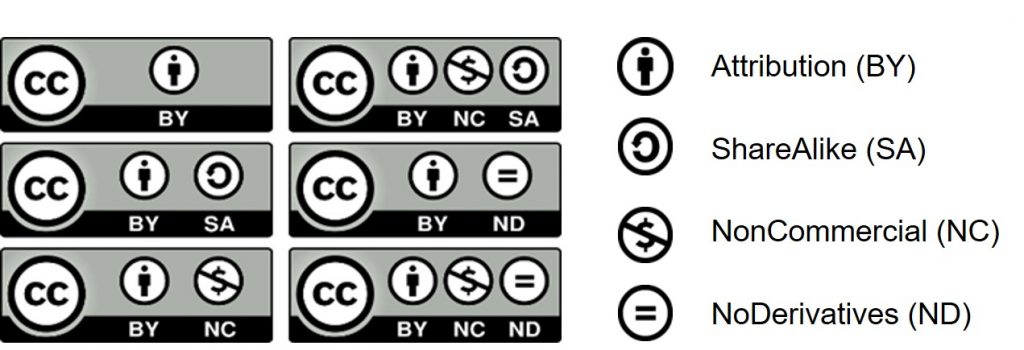Copyright, Creative Commons and Public Domain
Copyright
Whenever you produce a new creative or academic work – whether that is a new song, a picture, a slideshow, textbook, or study guide – you are automatically granted a copyright where all your rights are reserved. You do not need to do anything to be granted a copyright. The copyright is intended to protect your work from being used in ways you do not want, without your explicit or expressed permission.
Creative Commons Open Licensing
Creative Commons licences, are open licenses which act like copyright, but with permissions. They enable collaboration, development, access, and inspiration from your creative works without requiring you to give up the rights (copyright) automatically granted to you for your creation. Creative Commons (CC) is the global body that provides open-copyright licences, so as an author, you can give your permission to share and reuse your creative work, with the conditions you choose.
For example, in our OER by Discipline Guide, many of our resources are licensed under a Creative Commons Attribution 4.0 International Licence (CC-BY), which means you are able to share and adapt the content, as long as you give appropriate credit, provide a link to the licence, and indicate if changes were made.
When a creator applies one of the six licences on their work, they retain their copyright but allow the public to share, remix, adapt, and reuse the work legally without having to ask permission or pay additional fees, provided that the user complies with the conditions of the licence.
The six CC licences consist of three elements: the CC logo, icons representing a combination of conditions (which can also be represented by two letters or written out in long form), and the version (4.0 International is the most recent).

The most open of these licences is CC BY, requiring attribution only. The most restrictive (but still more open than copyright’s “all rights reserved” approach) is CC BY-NC-ND, which requires attribution but does not allow for commercial use and adaptations.
There is a wealth of information on the Creative Commons website or you can answer the questions in the following interaction to determine what license is right for you.
Other open licences sometimes found on OER
In some disciplines, such as computer science, engineering and mathematics, the following software licences are sometimes used:
GNU General Public License, version 3
Some OER created with the financial support of eCampusOntario’s Virtual Learning Strategy (VLS) have an Ontario Commons licence: OCL 1.0 or OCL-ND 1.0. The former is comparable to CC BY-NC while the latter is similar to CC BY-NC-ND, but with additional restrictions. The main difference is that they apply only to educators and students in the Ontario post-secondary sector (“Eligible Educators” and “Eligible Students”). Other uses by other members of the public require permission from the copyright holder.
Open licensing is a complex topic, but it is important to have a good understanding of your copyrights for the work you create, as well as the works you use, modify, and share. At McMaster University, you can contact copyright@mcmaster.ca for questions regarding copyright and oer@mcmaster.ca for open licensing.
Public domain
Items in the public domain are not protected by intellectual property laws, including copyright, trademark, or patent laws. Public domain belongs to the public. This means that no individual can claim any right to the material, and it can be used by anyone without obtaining permission.
Here are four of the typical ways that works end up in the public domain:
- The copyright has expired
- The existing copyright owner failed to renew the copyright
- The work was dedicated to the public domain
- Copyright law is not applicable to this type of work (example: short phrases, facts and theories, and U.S. government works)
*Note: Copyright law varies from country to country, and a work can be in the public domain in one country, but not necessarily in another.
- This section is adapted from the chapter “The How and Why of OER?” in the OER by Discipline Guide: University of Ottawa (Version 2.0 – June 2022) by Mélanie Brunet and Catherine Lachaîne. CC BY 4.0 ↵
- V. Clinton & S. Khan, (2019), “Efficacy of Open Textbook Adoption on Learning Performance and Course Withdrawal Rates: A Meta-Analysis,” AERA Open, CC BY-NC 4.0. R.S. Jhangiani et al., (2018), “As Good or Better than Commercial Textbooks: Students’ Perceptions and Outcomes from Using Open Digital and Open Print Textbooks,” The Canadian Journal for the Scholarship of Teaching and Learning 9(1). C. Hendricks et al., (2017), “The Adoption of an Open Textbook in a Large Physics Course: An Analysis of Cost, Outcomes, Use, and Perceptions,” The International Review of Research in Open and Distributed Learning 18(4), CC BY 4.0. H.M. Ross et al., (2018), “Open Textbooks in an Introductory Sociology Course in Canada: Student Views and Completion Rates,” Open Praxis 10(4), CC BY 4.0. ↵
